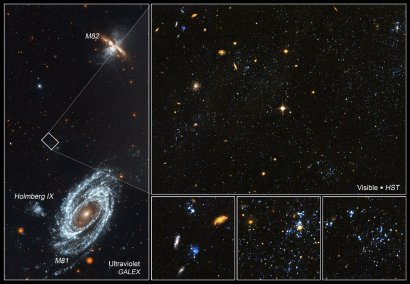Hubble finds that 'blue blobs' in space are orphaned clusters of stars [heic0801]
9 January 2008
Hubble has revealed that mysterious "blue blobs" in a structure called Arp's Loop between the galaxies M81 and M82 are blue clusters of stars less than 200 million years old with many stars as young as, and even younger than, 10 million years.
 |
|
The brilliant blue star clusters are resolved by Hubble's ACS instrument |
The powerful NASA/ESA Hubble Space Telescope has resolved the strange objects nicknamed "blue blobs" and found them to be brilliant blue clusters of stars born in the gas swirls and eddies induced by a galactic interaction 200 million years ago.
The findings are reported by Duilia de Mello of the Catholic University of America, Washington, D.C. and NASA's Goddard Space Flight Center, Greenbelt, Md. and her colleagues at the 211th meeting of the American Astronomical Society in Austin, Texas, USA.
Such "blue blobs" - each weighing tens of thousands of solar masses - have never been seen in detail before in such sparse locations, say researchers. They are more massive than most open clusters found inside galaxies, but a fraction of the mass of globular star clusters that orbit a galaxy.
Because the orphan stars don't belong to any particular galaxy, the heavier elements produced by nuclear fusion in these stars' interiors may easily be expelled back into intergalactic space. This may offer clues as to how the early Universe was enriched with heavier elements early in its history, say researchers.
The mystery is that the "blue blobs" are found along a wispy bridge of gas strung among three colliding galaxies, M81, M82, and NGC 3077, residing approximately 12 million light-years from Earth. This is not the place astronomers expect to find star clusters: in the "abyssal plain" of intergalactic space. "We could not believe it, the stars were in the middle of nowhere," says de Mello.
The "blue blobs" are clumped together in a structure called Arp's Loop, along the tenuous gas bridge. The gas filaments were considered too thin to accumulate enough material to actually build this many stars, says de Mello. But Hubble reveals the "blue blobs" contain the equivalent of five Orion Nebulae.
After finding that these blobs resolved into stars, the team used the Hubble image to measure an age for the clusters of less than 200 million years old with many stars as young as, and even younger than, 10 million years. Not coincidentally, 200 million years is the estimated age of the galactic collision that created the tidal gas streamers, pulled between the galaxies.
De Mello and her team propose that the star clusters in this diffuse structure might have formed from gas collisions and the subsequent turbulence, which enhanced the density of the gas streams locally. Galaxy collisions were much more frequent in the early Universe, so "blue blobs" should have been common. After the stars burned out or exploded, the heavier elements forged within these stars would have been ejected to enrich intergalactic space.
Radio observations with the Very Large Array of radio telescopes in Socorro, New Mexico, USA, gave a detailed map of the intergalactic bridge that revealed knots of denser gas. Studies with the 3.5m WIYN telescope on Kitt Peak in Arizona, USA, mapped the optical light glow of hydrogen along the bridge. Observations with NASA's Galaxy Evolution Explorer (GALEX) ultraviolet space telescope revealed an ultraviolet glow at the knots, and that earned them the nickname "blue blobs". But GALEX did not have the resolution to see individual stars or clusters. Only Hubble's Advanced Camera for Surveys at last revealed the point sources of the ultraviolet radiation.
Notes for editors
The Hubble Space Telescope is a project of international cooperation between ESA and NASA.
Image credit: NASA, ESA, and D. de Mello (Catholic University of America and GSFC)
Contact
Duilia de Mello
The Catholic University of America, Washington, D.C. and Goddard Space Flight Center, Greenbelt, Md., USA
Tel: +1-301-286-7497
E-mail: duilia.f.demello nasa.gov
nasa.gov
Lars Lindberg Christensen
Hubble/ESA, Garching, Germany
Tel: +49-(0)89-3200-6306
Cellular: +49-(0)173-3872-621
E-mail: lars eso.org
eso.org
Ray Villard
Space Telescope Science Institute, Baltimore, USA
Tel: +1-410-338-4514
E-mail: villard stsci.edu
stsci.edu
Robert Naeye
Goddard Space Flight Center, Greenbelt, Md.
Tel: +1-301-286-4453
E-mail: robert.p.naeye nasa.gov
nasa.gov

